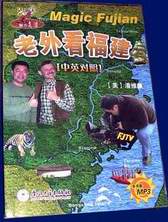![]() Click
to
Access
Click
to
Access
OUTSIDE China
![]() Click
to Access
Click
to Access
INSIDE
China ![]()
TRAVEL LINKS
![]() Xiamen
Xiamen
![]() Gulangyu
Gulangyu
![]() Jimei
Jimei
![]() Tong'an
Tong'an
![]() Jinmen
Jinmen
![]() Zhangzhou
Zhangzhou
![]() Quanzhou
Quanzhou
![]() Wuyi
Wuyi
![]() #1Fujian
Sites!
#1Fujian
Sites!
![]() Fujian
Foto Album
Fujian
Foto Album
![]() Books
on Fujian
Books
on Fujian
![]() Readers'Letters
Readers'Letters
![]() Ningde
Ningde
![]() Zhouning
Zhouning
![]() Longyan
Longyan
![]() Sanming
Sanming
![]() Putian
Putian
![]() Bridges
Bridges
![]() Travel
Info,
Travel
Info,
![]() Hakka
Roundhouses
Hakka
Roundhouses
![]() Travel
Agents
Travel
Agents
MISC. LINKS
![]() Amoy
People!
Amoy
People! ![]()
![]() Darwin
Driving
Darwin
Driving ![]()
![]() Amoy
Tigers
Amoy
Tigers
![]() Chinese
Inventions
Chinese
Inventions
![]() Tibet
in 80 Days!
Tibet
in 80 Days!![]()
![]() Dethroned!
Dethroned!
![]()
![]() Misc.Writings
Misc.Writings
![]() Latest
News
Latest
News
![]() Lord
of Opium
Lord
of Opium
![]() Back
to Main Page
Back
to Main Page
![]() Order
Books
Order
Books![]() Xiamenguide
Forum
Xiamenguide
Forum 

Fujian Bridges!
“Central
Fujian bridges are second to none under heaven”
.....................A Chinese saying
Excerpt from
"In and About Amoy" (191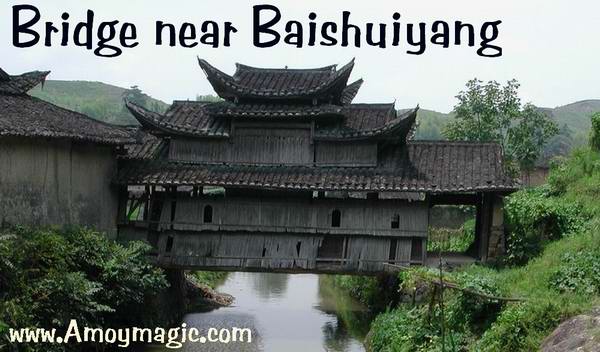 2,
p.297-8)
2,
p.297-8)
“The bridges of China are wonders! On some of them people build
their temples and houses and shops--where they live and carry on their
business. There are at least two bridges of this kind in the Amoy district,
each having a population of from fifty to one hundred inhabitants--perhaps
more. These bridges are generally of wonderful construction. How the largest
of them were built must always remain a matter of pure conjecture.
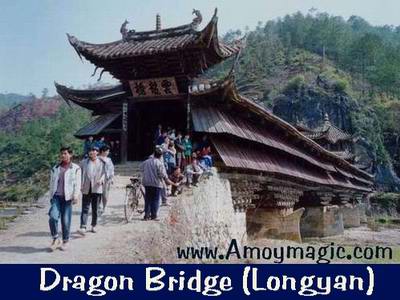 “Twenty-five
miles west of Amoy there is a famous bridge...There are natives who will
tell you that man could not have lifted, by any imaginable machinery,
to their present position those immense stones of which it is made. The
only conclusion they can come to is, the gods must have done the work.
“Twenty-five
miles west of Amoy there is a famous bridge...There are natives who will
tell you that man could not have lifted, by any imaginable machinery,
to their present position those immense stones of which it is made. The
only conclusion they can come to is, the gods must have done the work.
“The bridge
is called ‘The Po-lam Bridge’—a place much frequented
by foreigners residing in Amoy. It is 200 yards or more long, built upon
solid stone piers each about twelve feet high. Some of the stones laid
on these piers are of great length and weight. One of them is seventy
feet long, five feet thick and four feet wide, weighing something like
107 tons. It always has been a question: How were they put in place?”
........Pitch er,
"In and About Amoy," (1912, p.297-8)
er,
"In and About Amoy," (1912, p.297-8)
Back
to top
Land of Bridges
Quanzhou (ancient "Zaytun"--from which we get the word "satin")
is a land of bridges, both literally and metaphorically. Start of the
"Maritime Silk Road," Zaytun was not only the commercial and
cultural bridge between China and the rest of the planet (assuming they
were on the same planet), but it also gave us some of the world’s
most unique bridges, spanning rivers, gorges, and bays. Given our vertical
province’s tortuous topography, it is no wonder that Quanzhou folk
excelled in bridge-making. By the Song Dynasty, Minnan alone had at least
313 bridges.
My favorite bridges include the magnificent 700-year-old wooden covered bridge in Pingnan, Putian’s Ninggai Bridge (which is protected by a modern bridge built right over top), and Quanzhou’s magnificent Anping Bridge (longest stone bridge on earth) and Luoyang Bridge.
Before visiting
Quanzhou’s mythic bridges, view them through the eyes of Ms. Averil
Mackenzie-Grieve, a resident of South Fujian in the 1920s:
Back
to top
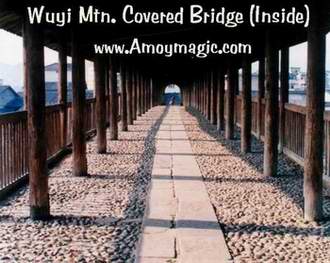
..(excerpt
from "A Race of Green Ginger")
“Galeote Pereira, when he was captured by the Chinese
as a smuggler in 1549, was taken through Ch’uan-chou [Quanzhou]
on his way to Foochow, and was greatly impressed with the populous countryside,
the ‘gallantly paved streets’ and, above all, ‘the very
noble and very well-wrought bridges of stone…for service over the
rivers’. Ch’uan-chou’s bridge was even more splendid
that Foochow’s bridge of Ten Thousand Ages, surpassed only by the
one spanning the Loyang river ten miles to the north. For me, the great
granite bridges of Fukien had an indescribable fascination. It lay, not
in their uniqueness (there are believed to be none like them in the world),
but, I think, in the grand, brave way in which they spanned the rivers,
set their broad buttresses against the currents. Their grey bulk had personality
and inspired respect; they reminded me of elephants. No one knows exactly
how the stones were put into place. The buttresses supported solid granite
slabs twenty-two feet long, two feet thick, laid, in the bridge over the
Loyang estuary, five abreast for over a thousand feet. At the roofed gateway
sat a massive stone figure, the twelfth-century builder himself. When
we saw them, their function had not altered in any way since they had
been built.
Back
to top

“For me, the
Roman coliseum rises yawning like an empty wasps’ nest; life has
gone from it. Even in Lucca, whose coliseum is a teeming hive of cell-slums,
built with the help of Lombardic bricks and Romanesque hewn stones, builders
and users are buried in history—remembered it is true, but as a
legend. But across the great stone Fukienese bridges the people swarmed,
thinking, acting, writing, talking, exactly as their forebears had done
for more than seven hundred years. The stream of pole-carriers, litter-bearers,
pedestrians, flowed unbroken throughout the centuries, the strong tide
of life undiminished, undiluted; an endurance so close-textured, so ubiquitous
that, living in China, one accepted it and only afterwards was amazed.”
(Excerpt from, 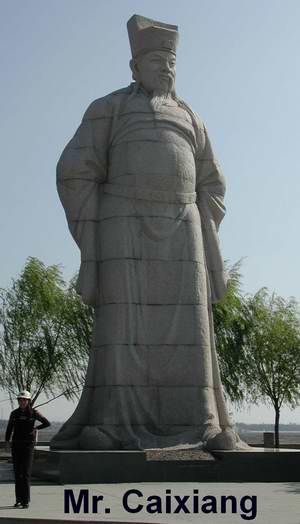 “A
Race of Green Ginger,” p.112,113)
“A
Race of Green Ginger,” p.112,113)
Quanzhou’s three most famous bridges are Luoyang Bridge, Anping Bridge, and Dongguan Bridge. Dongguan, in Yongchun, is a bit off the beaten path, so we’ll visit it after we’ve seen two marvelous bridges just off the 324 national highway.
Anping
Bridge This recently renovated 2,251m bridge was the longest
bridge on earth during the Middle Ages, and is still the longest stone
bridge today. It was built in 1138 in Anhai by the monk Zupai as a replacement
for the ferry, and wasn't completed until 1151. He used massive granite
slabs, most of which are said to have been shipped from nearby Jinmen
Island (Quemoy). It was originally called the Five Mile Bridge because
it was Five Li (Chinese Miles) long--but I’m not sure if they were
the long li, short li, mandarin li or common country li. Whichever li,
the bridge is a long walk on a hot summer day, so take it slowli.
Back
to top
Luoyang Bridge
To the north of Quanzhou city lies China’s first seaport bridge,
the Luoyang Bridge. Though shorter than Anping, it is older—and
my favorite by far.
Before Mr. Cai Xiang
(1012-1067) was able to overcome incredible difficulties to erect the
Luoyang Bridge, traversing the Luoyang river required travelers to spend
an entire day going inland, or to chance crossing on small craft that
were often sunk by squalls sent by evil spirits. In 1053, Quanzhou prefect
Cai Xiang, who was born in Xianyou and became a Jinshi at the tender age
of 19, decided to remedy the situation by building a stone bridge at the
mouth of the Luoyang River.
Mr. Cai Xiang used many innovative engineering techniques, including what
may be one of the planet’s first attempts at biological engineering.
The piers were ingeniously shaped like a ship’s bow to divert the
raging tides. Chinese, always poetic, call them “10,000 ships launching.”
(They miscounted by 9,900 but that’s “liway”, remember).
The pillars’ massive granite blocks were held together with butterfly-shaped
iron wedges (hence the origin of “Iron Butterfly”—almost
400 years after Kaiyuan Temple’s “Purple Haze”).
The pillars were further reinforced with live oysters, whose natural secretions
cemented the blocks together. (I asked my guides how they trained the
oysters to cooperate but they clammed up on me).
Back
to top
The granite slabs were up to 10 meters long and one meter
wide, and weighed ten tons. Each time I traverse the bridge, I marvel
that the ancients could have even hewn the mammoth blocks, much less transported
them to the Luoyang River, where they battled its legendarily ferocious
currents to set them in place.
Historical records relate that the completed bridge was 834 meters long by 7 meters wide, and had 500 stone sculptures to serve as railings, all supported upon 46 piers (talk about pier pressure!). Over 700 pine trees were planted on both ends of the bridge, and as further protection from typhoons, the bridge was armed with 28 stone lions, 7 pavilions, 9 towers, and numerous stone warriors.
Back
to top
A Border Stone
in the middle bears the characters Jin-Hui JiaoJiang because the center
of the bridge lay on the border between Hui'an and Jinjiang.
The bridge stood largely unchanged for centuries. Even during the 8.0 earthquake almost 400 years ago (which toppled Ashab Mosque’s dome), the bridge suffered only minor damage. But Japanese invaders accomplished what nature could not. In the center of the bridge is a Pusa that used to have a moonstone in her forehead. It supposedly glowed at night, guiding seamen to safety--until the Japanese stole it.
1 Million Yuan Renovation! Luoyang bridge was renovated several times after 1949. The renovation in the early 90s cost over 1 million Yuan. When I asked why it was so costly, an official said, “Because nowadays we have to dig away half a mountain to find a ten meter slab of granite!” I was told.
Maybe they could try shorter pieces and lots more oysters?
Cai Xiang Memorial
Temple ,
(Cai Xiang Ci), is south of Luoyang Bridge. Within is a stone tablet,
“The Records of Building Wan’An Bridge,” inscribed by
the great bridge builder himself. “Wan ‘An” (10,000
Peace) was another popular name for Luoyang bridge.
,
(Cai Xiang Ci), is south of Luoyang Bridge. Within is a stone tablet,
“The Records of Building Wan’An Bridge,” inscribed by
the great bridge builder himself. “Wan ‘An” (10,000
Peace) was another popular name for Luoyang bridge.
Back to top
Making Waves One large sunbaked
stone has a natural formation resembling a snake and a turtle head. It
is said that before the bridge was built, a snake and turtle lived here
and caused the waves. On the other side of the stone, four characters
say “God (Shangdi, ??) sat here.” Obliging locals will point
out the impression left by Buddha’s buttocks when he sat there trying
to dissuade the snake and turtle from wreaking such havoc with the tides
and waves.
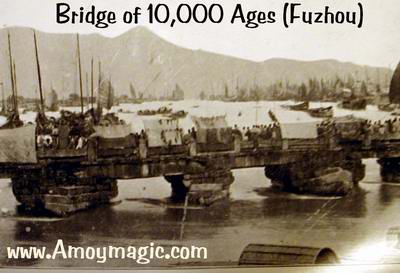 Sichuan or Xichuan
There is a fascinating legend behind the pavilion with “Xichuan”
inscribed upon it. During the Ming Dynasty, when Quanzhou was suffering
from a prolonged drought, the Mayor of Quanzhou, Fang Ke, asked people
to pray for rain. Evidently, their god wasn’t up on geography because
he sent an angel to give Sichuan (the west of China) a good wetting down.
Sichuan or Xichuan
There is a fascinating legend behind the pavilion with “Xichuan”
inscribed upon it. During the Ming Dynasty, when Quanzhou was suffering
from a prolonged drought, the Mayor of Quanzhou, Fang Ke, asked people
to pray for rain. Evidently, their god wasn’t up on geography because
he sent an angel to give Sichuan (the west of China) a good wetting down.
As the angel passed
through Quanzhou he took pity upon the parched landscape, but he dared
not release the rain anywhere but the god’s designated target. But
Mayor Fang Ke was a savvy politician. He renamed the area Xichuan, evidently
figuring that god could not read (because the characters are different
even if they sound similar). The angel must have agreed about his lord’s
literacy, because he released his rain upon Quanzhou (and Sichuan had
to make do with bottle water). Hence the stone pavilion’s inscription,
“Xichuan Ganyu” (????), which I was told meant, “Water
is precious, one drop is invaluable.”
Back
to top
Arm and a Leg A
village temple north of the bridge used to be the bridge construction
office, and is dedicated to the god who safeguarded its construction.
The last Zhuangyuan of the Qing Dynasty, from Jinjiang, wrote the inscription
above the temple door.
The temple has a red faced idol of an ancient monk, whom locals revere because, according to legend, when the people lacked fuel for cooking he used his own leg as firewood. “The monk really existed!” I was told, “Though we can’t prove the leg story.”
Personally, I thought
they were just pulling my leg. But I confessed, “American restaurants
are worse. They charge an arm and a leg.”
Getting to Luoyang Bridge: Buses, 10, 13, and 19
Hours: 8:00 – 17:30 Phone: 265-1816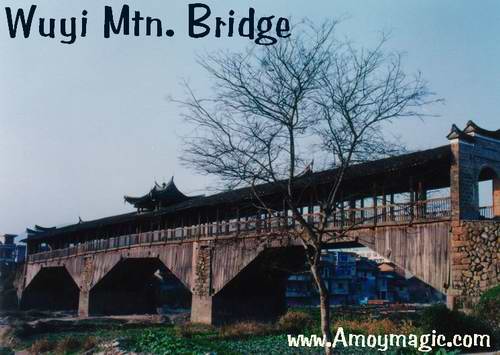
Luoyang Cuisine
Speaking of food... Luoyang has some legendary seafood—and it doesn’t
cost an arm or a leg. Awesome oysters, the size of small eggs; steamed
fish soup, washed down by oolong tea that is all the better because of
the excellent local spring water; and crabs that are supposedly better
than Xiamen’s because they are wild, not cultivated, and served
in a thick sauce much like a Western gravy, but redolent of Chinese medicinal
herbs. Heavenly.
Back
to top
The Legend of Luoyang Bridge
Neptune’s
Advice
There are many legends about Cai Xiang. One says he tried ten times to
lay Luoyang Bridge’s foundation, but each time it was swept away
by the powerful tides. In frustration, he sent an officer to find the
Sea God and ask advice. The officer returned from who knows where with
a one word suggestion, “Vinegar.” Cai Xiang interpreted this
cryptic word, and laid the bridge successfully.
Rev. Pitcher (“In and About Amoy”, 1912) shares one of my
favorite accounts:
“It was during one of these squalls that a very remarkable thing happened, which led to the building of the bridge. At this particular time, while a large boat load of passengers was being ferried across, a storm came down upon them in wildest fury. Just when all hope was about to be abandoned of ever reaching the shore a voice rang out above the storm commanding one named Cai (?)to build a bridge across this dangerous point of the sea. They were soon after all safely landed. It was discovered later that there was but one person by the name of Cai living in that neighborhood. It was also learned that he had only just married, and that it had been revealed to his wife in some mysterious manner that she would be the mother of the man who was to build the bridge.
“In due time
the child was born who was named Cai Xiang and grew up a precocious youth.
In his young manhood he became a mandarin. His mother took pains to tell
him what had occurred in the storm, of what had been revealed to her years
before, and what his mission therefore in life might be expected to be.
Young Cai became deeply impressed and took steps at once to secure an
appointment as mandarin in his native prefecture that he might undertake
his appointed task. He knew it was against all custom and law for one
to be appointed to office in his own district, he was therefore not a
little puzzled to know how this desire of his was to be brought about.
But fortune often favors those who are in earnest and in course of time
circumstances brought out friend Cai to the palace of the Emperor, where
he hit upon a novel as well as bold idea to accomplish his wish.
Back
to top
“One day while walking in the Imperial grounds he took a pot of honey and wrote on a tree this sentence—“Cai Xiang the learned, be magistrate in your native prefectural city.” Sometime after the Emperor came walking along, and what his surprise was can only be imagined when he saw this sentence now emblazoned on a tree in living characters of armies of black ants that were feeding on the honey. His surprise found expression as he read out in a loud tone of voice, “Cai Xiang the learned, be magistrate in your native prefectural city.” Mr. Cai was conveniently near at hand, and at the same time innocently enough took the words of the Emperor as an appointment to the office he so much desired, and proceeded without delay to thank his sovereign for the great honor he had conferred on him. Though the Emperor protested that that was not at all his meaning—that he was merely reading the sentence which the ants had written (which by the way Cai had taken good pains to bring about, having carefully selected a tree with an ant nest at the base)—he held his majesty to the words as his intention to appoint him to this office. Finally the Emperor yielded...
“He began at once making preparation for building the bridge. His greatest task was in laying the foundations for the central piers as in that particular spot the rushing current never ceases its flow and ebb. How to sink the foundations there puzzled Cai Xiang for many a day, when it occurred to him to write to Neptune on the subject, asking him to be kind enough to keep the waters back from the place for one brief day, and to be so accommodating as to mention the date when that would occur. Then the question arose who was to take this letter to old Neptune.
In answer it was
discovered that there was a man living near by whose name was ‘Able
to Descend into the Sea.’ This man was pressed into service and
like a bold knight he set out to fulfill his mission, by laying himself
down in a comfortable and dry spot where he proposed to stay until the
incoming tides covered him, when he could communicate with the god of
the waters. While he was waiting he fell asleep. How long he slept will
never be known, but when he awoke he found the letter gone, and another
addressed to Cai Xiang, though he was in the same spot that he was when
he went to sleep.
Back
to top
The letter was delivered to Cai Xiang. It contained but a single character ? (vinegar). It was indeed as gall and vinegar to receive such a message, for whatever could it mean! Struggle as he might with it, search his brain hard and long, he could make no sense out of it. Finally he began to break up the character into its different compound parts, and thereby he solved the problem and received his answer from old Neptune. The reply was that at evening on the 21st of the month the waters would be stayed. These directions were followed, the foundations successfully sunk and in due time the building of the wonderful bridge completed.”

Dongguan Bridge
wooden covered bridge, between Dehua and Putian, is remote, but this provincial
level protected relic is a beauty—especially since an Overseas Chinese
donated 1 million Yuan to renovate it. Built in 1145 A.D. (15th year of
Shaoxing in South Song Dynasty, in case you’re dying to know), in
Dongmei Village, Dongping Township, this magnificent 85m by 5m wooden
beam bridge spans the scenic Humei Brook.
Like other ancient
wooden bridges, it has a shrine in the middle, and religious paintings
on the beams above. The wooden bridge is supported by stone block columns,
with the upstream side shaped like a ship’s bow to deflect heavy
currents (they learned this from Luoyang and Anping bridges).
Getting There: Special bus from Quanzhou to Yongchun
Hours: 8:00—17:30 Phone: 388-4202
Back
to top
Xiamen
Bridge Museum
Though in Xiamen, not Quanzhou, this is right next door, and the best
way to appreciate China’s contributions to bridge building. The
museum has models and photos of bridges all over China, as well as the
rest of the world, as well as the best location to take photos of Xiamen’s
beautiful Haicang Suspension Bridge. (I’d tell you what world records
it has set, but I want to keep you in suspense).
![]() Favorite
Fujian Sites
Favorite
Fujian Sites ![]() Fujian
Foto Album
Fujian
Foto Album ![]() Xiamen
Xiamen
![]() Gulangyu
Gulangyu
![]() Fujian
Guides
Fujian
Guides ![]() Quanzhou
Quanzhou
![]() Zhangzhou
Zhangzhou
![]() Longyan
Longyan
![]() Wuyi
Mtn
Wuyi
Mtn ![]() Ningde
Ningde
![]() Putian
Putian
![]() Sanming
Sanming
![]() Zhouning
Zhouning
![]() Taimu
Mtn.
Taimu
Mtn. ![]() Roundhouses
Roundhouses
![]() Bridges
Bridges
![]() Jiangxi
Jiangxi
![]() Guilin
Guilin
![]() Order
Books
Order
Books
![]() Readers'
Letters
Readers'
Letters
Last Updated: May 2007
![]()
DAILY
LINKS
![]() FAQs
Questions?
FAQs
Questions?
![]() Real
Estate
Real
Estate
![]() Shopping
Shopping
![]() Maps
Maps
![]() Bookstores
Bookstores
![]() Trains
Trains
![]() Busses
Busses
![]() Hotels
Hotels
![]() News
(CT)
News
(CT)
![]() Medical
& Dental
Medical
& Dental
![]() YMCA
Volunteer!
YMCA
Volunteer! ![]()
![]() XICF
Fellowship
XICF
Fellowship
![]() Churches
Churches
![]()
![]() Expat
Groups
Expat
Groups
![]() Maids
Maids
![]() Phone
#s
Phone
#s
EDUCATION
![]() Xiamen
University
Xiamen
University
![]() XIS(Int'l
School)
XIS(Int'l
School)
![]() Study
Mandarin
Study
Mandarin
![]() CSP(China
Studies)
CSP(China
Studies)
![]() Library
Library
![]() Museums
Museums
![]() History
History
DINING
![]() Restaurants
Restaurants
![]() Asian
Asian
![]() Veggie
Veggie
![]() Junk
Food
Junk
Food
![]() Chinese
Chinese
![]() Italian
Italian
![]() International
International![]()
![]() Visas
4 aliens
Visas
4 aliens
RECREATION
![]() Massage!
Massage!
![]() Beaches
Beaches
![]() Fly
Kites
Fly
Kites
![]() Sports
Sports
![]() Boardwalk
Boardwalk
![]() Parks
Parks
![]() Pets
Pets
![]() Birdwatching
Birdwatching
![]() Kung
Fu
Kung
Fu ![]() Hiking
Hiking
![]() Music
Events
Music
Events
![]() Festival&Culture
Festival&Culture
![]() Humor&
Humor&![]() Fun
Fotos
Fun
Fotos![]()
BUSINESS
![]() Doing
Business
Doing
Business
![]() Jobs!(teach/work)
Jobs!(teach/work)
![]() Hire
Workers
Hire
Workers
![]() Foreign
Companies
Foreign
Companies
![]() CIFIT
(Trade Fair)
CIFIT
(Trade Fair)
![]() MTS(Translation)
MTS(Translation)
![]()
Back to Top





